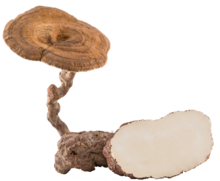
Lignosus rhinocerotis

Lignosus rhinocerus, commonly known as tiger milk mushroom, belongs to family Polyporaceae in the division Basidiomycota. Tiger milk mushroom is regarded as a medicinal mushroom with the ability to cure numerous ailments. This fungus is geographically distributed only in tropical rainforests in the region of South China, Thailand, Malaysia, Indonesia, Philippines and Papua New Guinea. In Malaysia, the tiger milk mushroom is more often known as 'Cendawan Susu Rimau' and is hailed as Malaysia’s national treasure. It has been used traditionally as a health tonic. According to folklore, the name is based on a story in which the relatively uncommon fungus grows on the spot where a tigress drips her milk while feeding her cubs. The tiger milk mushroom was first reported in 1664 when a European government agent was given this product upon sailing to the South East Asian Region. According to The Diary of John Evelyn (Publication dated 22 June 1664), this mushroom was named ‘Lac tygridis’, meaning 'tiger’s milk'. In his publication, Evelyn also recorded that this fungus was used by the local people to treat diseases for which European doctors found no cure. In 1890, Sir Henry Nicholas Ridley, the father of Malaya’s rubber industry, recorded that this fungus was an important medicinal mushroom used by local communities. He even attempted to cultivate it but failed. In the same year, this fungus was scientifically documented by Mordecai Cubitt Cooke who named it as Fomes rhinocerotis based on a specimen found in Penang. Today, it is known by the scientific name Lignosus rhinocerus. Lignosus rhinocerus has a centrally stipulate pileus–that is, a mushroom cap growing at the end of a stipe (stem) arising from a district buried tuber or sclerotium. Unlike most other type of mushrooms, this fungus has unique growth habit in that their growth is solitary, and can find only one fruit body at time. This species classified as precious and rare because of its uniqueness of the growth habit where distance between one fruit body to another is not less than 5 km. Tiger milk mushroom believed to emerge from the very spot where the milk of a prowling tiger has dropped on the ground. The underground fungus has tuber/sclerotia where it will remain there for month, years and decades. The presence of this sclerotium can only be noticeable when the mushroom sprouts out. Medicinal properties of tiger milk mushroom only found in underground tuber or sclerotium, but unfortunately formation of cap and stem would have depleted most of its essence. Tiger milk mushroom has been used traditionally for over 400 years as a health tonic by the aborigines or native for its healing properties on more than 15 types of medical ailments including treat lung and respiratory disease such as asthma, cough, fever, vomit, breast cancer, chronic hepatitis, gastric ulcer, food poisoning, healing wound and indigestion. Aborigines also boil it with Tongkat ali and used it as general tonic to strengthen the body. As a result of its unique growth habit, it is difficult to find. Although the medicinal value of tiger milk mushroom is widely known, the inconsistent supply of raw material and uneven quality of the harvest coupled by lack of research, causing many potential of the traditional health tonic cannot be further explored. In the past, this mushroom has never been able to enter large-scale commercialization, until Tan Chon Seng, a researcher from MARDI (Malaysian Agricultural Research & Development Institute) made a breakthrough in 2008 by successfully cultivating tiger milk mushroom with solid fermentation technology.
